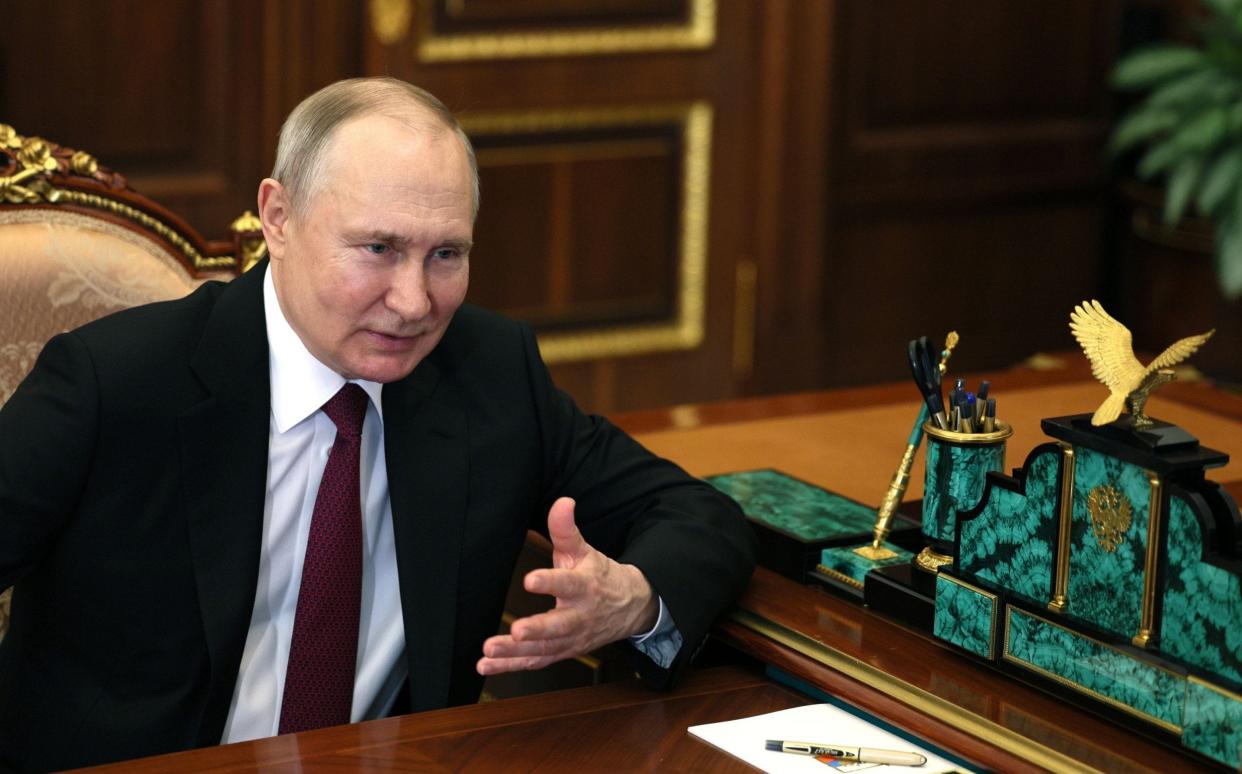Vladimir Putin may at last be glimpsing victory

- Oops!Something went wrong.Please try again later.
The precise veracity of the large cache of intelligence documents that have apparently been leaked from the Pentagon might be open to question, but there can be little doubt about the negative impact that they are having on Ukraine’s war effort. Even if the release of the documents turns out to be part of a clever disinformation campaign by the Kremlin’s cyber-trolls, it could nevertheless prompt Ukraine’s high command to rethink its long-planned counteroffensive against Russian forces.
Throughout the winter, Ukrainian troops have been undergoing rigorous training in advance of launching a new wave of attacks this spring against their Russian occupiers, aiming to make a decisive breakthrough of the Kremlin’s ill-equipped and deeply demoralised front lines.
Preparations for the offensive have included sending large detachments of Ukrainian troops to Europe for training, with several thousand being mentored by the British Army. When the most recent consignment of Ukrainian volunteers began the long journey home from Salisbury Plain earlier this month, British troops formed a guard of honour with cries of “Slava Ukraini” – Glory to Ukraine – echoing through the ranks.
Nor does the planned offensive lack ambition. There has even been talk of the Ukrainians attempting to recapture the Crimean peninsula, home to Russia’s Black Sea naval fleet, which was occupied and illegally annexed by the Kremlin in 2014. While senior US military officials have questioned Ukraine’s ability to inflict such a devastating blow on the Russians, last month’s drone strikes, which destroyed stocks of Russian cruise missiles in northern Crimea, suggest that the Ukrainians are deadly serious about achieving their goal.
Yet, with a dozen new Ukrainian brigades said to be ready to join the fray – some of them equipped with Western equipment such as Britain’s Challenger 2 tanks and AS-90 self-propelled artillery guns – Ukrainian commanders have suddenly been forced to reassess their plans.
Some of the claims made in the leaks – such as the suggestion that Britain has 50 special forces operating in the war-torn country – have been dismissed, in this case by the Ministry of Defence, which called it “misinformation”. In the murky world of counter-espionage, it is often difficult to distinguish fact from fiction, and even if the leaked material does relate to live intelligence generated by the US and its allies, there is always the possibility that it has been subjected to Russian manipulation.
Nevertheless, there is a significant amount of detail that does seem to be highly plausible – and while some facts may have been altered (for example Russian and Ukrainian casualty figures), US officials have acknowledged that the bulk appears to be genuine.
Perhaps most alarming for Kyiv will be the evidence of the Americans’ somewhat downbeat opinion of Ukrainian forces’ ability to mount and sustain major offensive operations.
The damning assessment of Ukraine’s air defences, for example, which are said to be in danger of being overwhelmed without significant quantities of additional weapons, is a serious concern. The Ukrainians have been warning for months that, without fresh supplies of Western warplanes, such as F-16 fighters, and missiles, they will be vulnerable to Russian attacks. Certainly, no rational Ukrainian commander will want to risk the newly constituted combat brigades without being able to provide effective air cover.
The documents also seem to confirm what many of us have feared since the outset of this terrible conflict: that some Western leaders have little faith in Ukraine’s ability to achieve victory. One document from early February expresses misgivings about the prospects of Ukraine’s forthcoming counter-offensive, warning that problems with generating and sustaining sufficient forces will only result in “modest territorial gains”.
It could be, then, that even Kyiv’s strongest allies believe the Ukrainian conflict is heading for a bloody stalemate. This could embolden those Western leaders who already have reservations about maintaining their support for Ukraine. This could even have an impact on their commitment to sending weaponry and other aid, which will alarm Kyiv because it has been facing crippling shortages. A lack of ammunition has recently seen some of Ukraine’s frontline forces being reduced to firing only two shells a day, compared with 20-30 previously.
These assessments will certainly lend encouragement to Moscow’s forces which, while lacking the means to conduct their own offensives, have succeeded in strengthening their defences. According to the latest British military intelligence reports this week, the Russians have completed the establishment of three new lines of defensive formations along a 75-mile long stretch of the Zaporizhzhia region in eastern Ukraine to protect Crimea from attack.
Irrespective of the validity of the information contained in the leaked documents, the Ukraine conflict may be nearing a watershed moment, one where, without Kyiv receiving more support from the West, there is a real risk of the war ultimately turning in Vladimir Putin’s favour.

